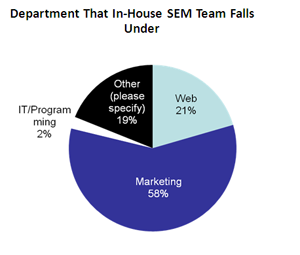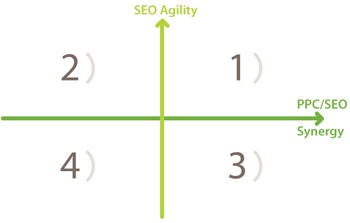Organizational Structure for Paid and Natural Search Teams
- Thought Leadership
- By Seth Besmertnik
- 4 minutes read
How do marketing executives structure their paid and natural search teams? Here are a few POVs on where these teams belong in the organization.
On a list-serv of digital business leaders I belong to, the Head of Customer Experience of a well-recognized Fortune 100 tech company recently asked if list members manage SEO and SEM together in one group, and where in the organization SEO should sit. We get asked the same questions fairly frequently so here are our thoughts on the topic.
Historically, Paid Search has consistently sat in the Marketing department, while SEO can found in a number of different groups all over the organization including Marketing, Product, Technology & Web Operations; most recently, we tend to find it in the Marketing Group while a small, but growing amount, of our B2C customers with large public sites sometimes manage it out of the Product Management group. SEMPO’s most recent data on where in the organization the SEM team falls supports this view, with responses that include at least four distinct groups across the organization:

Managing SEO out of the Product group has its advantages, including enabling close ties between natural search and product/web design, and catalyzing thinking early in the design and development process about how best to reach prospects and customers online. You are also not competing for engineering resources as aggressively as you are when its coming “down the marketing pike” to your tech group.
We have found most companies managing SEO out of Product tend to have senior executives with strong beliefs in SEO as a core business strategy. The SEO professionals in these kinds of organizations tend to be extremely empowered, agile and productive; they are be able to execute on advanced strategies and tactics such as preferred URL management, SEO A/B testing and are not afraid to experiment, and they are also usually amongst the “happier” SEO people, especially if they came from a company where it took 90 days+ to get minor things done.
Opportunity for Paid & SEO Synergy
When it comes to SEO and PPC working together, no matter where in the organization they have historically been found, there hasn’t been sufficient communication between the two groups – the classic example we’ve all heard about (perhaps even experienced) of the paid and natural practitioners who sit next to each other, but never “talk” to each other. This has resulted in significant missed synergy (sorry to break out the S word) since there are numerous opportunities to leverage paid and natural search data together to yield a greater outcome. Whether it’s leveraging paid data to guide SEO, or the studies that show CTRs improve when ranking for a term in both paid and natural search listings, the opportunities are there for the taking.
(We built an integration of our Conductor SEO Platform with Omniture’s Paid Search Platform , SearchCenter+, to combine paid and natural search data together in one place and take advantage of this synergy…)
Most recently, we are starting to see a trend towards a common "Search Team"—a singular group with an overall common search goal—based on traffic, spend, etc. I like this approach. It forces the groups to work together and turn search into a holistic endeavor with shared goals. We are moving into a world where instead of having SEO and PPC goals, you will have Search Goals, a Search budget, and a common mission of driving traffic from search engines to maximize visitor acquisition.
Position SEO in the Organization Where it Will Obtain the Maximum Benefit
So, we think it makes a ton of sense for these functions to sit together under a common leader. However, not at the expense of SEO agility. As you can see from the graphic below, the ideal position for SEO in organization is to be in is one of maximum agility and maximum synergy, or strive to be as close to that as possible.

If the Marketing group does not command cross-functional resources that are often available in Product (or vice versa), I’d prefer to have them in separate groups, than be constrained in the same group. After all, you can still have these teams working closely without having a common report. The bottom line is that unlike every other marketing strategy, SEO requires involvement from multiple groups across the enterprise to yield its greatest return. It is this challenge that leaves you with the largest white-space customer acquisition opportunity on the web. Your ability to corral teams, work smart and collaborate with others will determine your success.







